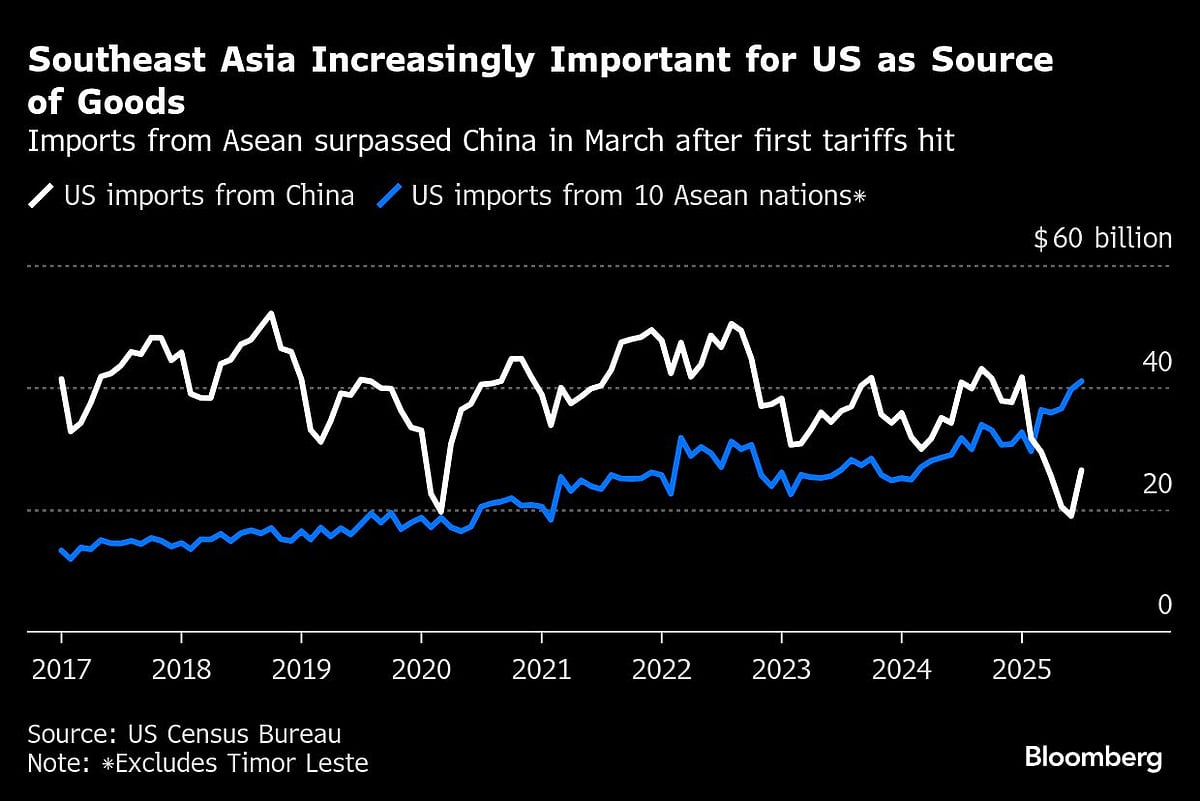Trump’s Trade Deals Give US Edge Over Southeast Asia
The benefits to the four Southeast Asian nations were less clear, though. They failed to negotiate a lower tariff rate than the 19%-20% initially imposed by Trump.

US President Donald Trump came to Southeast Asia wielding trade deals his office hailed as “historic.” The finer details, though, suggest a set of agreements that are uneven and with plenty of unknowns.
In a whirl of activity after landing in the Malaysian capital of Kuala Lumpur on Sunday, Trump unveiled trade agreements with Malaysia and Cambodia, as well as the frameworks of deals with Thailand and Vietnam.
Read More: Trump Unveils Flurry of Asia Trade Deals Ahead of Xi Meeting
The pacts give Trump some clear wins, like the removal of many tariff and non-tariff barriers on US exports into those countries and pledges to spend billions of dollars on American goods.
The benefits to the four Southeast Asian nations were less clear, though. They failed to negotiate a lower tariff rate than the 19%-20% initially imposed by Trump, and while some exports from Cambodia and Malaysia would be exempted from levies, the categories appeared to be limited.
The “one-sided” deals carry “clear costs and vague benefits for Southeast Asia,” Bloomberg Economics’ Tamara Henderson and Adam Farrar wrote in a note. “The agreements seem set to roll back tariffs and regulations on US goods coming into Southeast Asia — a threat to domestic industry already feeling the squeeze from broad US trade tariffs.”
Barclays Plc estimates that the tariff exemptions given to Malaysia apply to about $12 billion of its exports to the US, equivalent to 2.8% of gross domestic product. However, about $11 billion of that amount would be subject to limitations, which means only about $1 billion of exports to the US — or 0.2% of Malaysia’s GDP — would receive a zero tariff rate.
“While the list of Malaysian products that will be exempted from reciprocal tariffs under the agreement looks significant, most of these are subject to limitations — and the actual positive impact is likely to be relatively limited,” Barclays economists led by Brian Tan wrote in the note.
Malaysia’s stock market declined on Tuesday after modest gains on Monday, when the stock benchmark underperformed most of Asia’s biggest markets, suggesting investors had priced in the trade deals. The ringgit was up 0.2% on Tuesday.
‘Bit of a Puzzle’
Besides lowering tariffs, many of the trade pacts included commitments to purchase US goods and commodities, such as almost $150 billion worth of US semiconductor, data center and aerospace goods and equipment by Malaysian firms.
“The counterparties are agreeing to do an awful lot of difficult things,” said Deborah Elms, head of trade policy at the Hinrich Foundation, a Singapore-based philanthropic organization. That includes removing tariffs on US goods and aligning on a lot of other US policies “which could mean anything and everything,” she said.
“And in exchange for what?” Elms said. “This is a bit of a puzzle.”
Looming over the deals is the tariff wall Trump erected against China, and his upcoming meeting Thursday with its leader, Xi Jinping.
The trade deals are crucial for the Association of Southeast Asian Nations, the 11-member grouping known as Asean. The bloc is now a larger supplier of goods to the US than China, which has a GDP more than four times as large as Asean’s roughly $4 trillion.
Asean is also forging closer trade ties with China. On Tuesday, the bloc’s leaders signed an upgraded free trade agreement with Beijing at the Kuala Lumpur summit.

By far the biggest contributor has been Vietnam, which accounted for about $18 billion of the $41 billion in regional exports to the US in July, the latest month of available data.
“The details are still scant, such as goods Vietnam will get special exemptions for or rules of rerouting,” said Trinh Nguyen, senior economist for emerging Asia at Natixis. “But the general spirit is that there is a deal, and Vietnam is in the game of trade to the US for the long-haul, even if there is heightened US-China tensions.”
Jamieson Greer, the US trade representative, said some tariff exemptions on exports like coffee would “make sense to give them a good deal” on things that aren’t made in the US.
Another key unanswered question is how the US will determine what it considered a “transshipped” good, which are subject to 40% tariffs, and whether that levy would be in addition to the reciprocal rate already imposed.
That punitive duty is designed to discourage the rerouting of goods from China to avoid higher tariffs, but the lack of details about what it entails has been a source of ongoing uncertainty for manufacturers and authorities. Malaysia’s Trade Minister Zafrul Aziz indicated in a briefing Sunday that the issue hasn’t been resolved.
Cambodian Deputy Prime Minister Sun Chanthol said the country was “pleased” with the deal but still hoped for exemptions on garments and footwear, which make up about 50% of the country’s exports.
Thailand’s Commerce Minister Suphajee Suthumpun noted in a statement that the framework is non-binding and detailed talks will follow, with the aim of concluding negotiations by the end of the year.
Malaysia’s Zafrul said the deal offers better access to US markets, exemptions for Malaysian palm oil, cocoa and pharmaceuticals. Prime Minister Anwar Ibrahim also indicated the US would be willing to negotiate on tariffs on semiconductors.
“It’s much better than what I expected — the trust, the friendship and the commitment to enhance relations,” Anwar said of talks with Trump.

